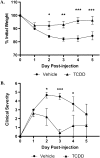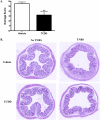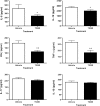Aryl hydrocarbon receptor activation by TCDD reduces inflammation associated with Crohn's disease
- PMID: 21131560
- PMCID: PMC3044199
- DOI: 10.1093/toxsci/kfq360
Aryl hydrocarbon receptor activation by TCDD reduces inflammation associated with Crohn's disease
Abstract
Crohn's disease results from a combination of genetic and environmental factors that trigger an inappropriate immune response to commensal gut bacteria. The aryl hydrocarbon receptor (AhR) is well known for its involvement in the toxicity of 2,3,7,8-tetrachlorodibenzo-p-dioxin (TCDD), an environmental contaminant that affects people primarily through the diet. Recently, TCDD was shown to suppress immune responses by generating regulatory T cells (Tregs). We hypothesized that AhR activation dampens inflammation associated with Crohn's disease. To test this hypothesis, we utilized the 2,4,6-trinitrobenzenesulfonic acid (TNBS) murine model of colitis. Mice were gavaged with TCDD prior to colitis induction with TNBS. Several parameters were examined including colonic inflammation via histological and flow cytometric analyses. TCDD-treated mice recovered body weight faster and experienced significantly less colonic damage. Reduced levels of interleukin (IL) 6, IL-12, interferon-gamma, and tumor necrosis factor-α demonstrated suppression of inflammation in the gut following TCDD exposure. Forkhead box P3 (Foxp3)(egfp) mice revealed that TCDD increased the Foxp3+ Treg population in gut immune tissue following TNBS exposure. Collectively, these results suggest that activation of the AhR by TCDD decreases colonic inflammation in a murine model of colitis in part by generating regulatory immune cells. Ultimately, this work may lead to the development of more effective therapeutics for the treatment of Crohn's disease.
Figures





Similar articles
-
Activation of aryl hydrocarbon receptor (AhR) leads to reciprocal epigenetic regulation of FoxP3 and IL-17 expression and amelioration of experimental colitis.PLoS One. 2011;6(8):e23522. doi: 10.1371/journal.pone.0023522. Epub 2011 Aug 15. PLoS One. 2011. PMID: 21858153 Free PMC article.
-
Activation of aryl hydrocarbon receptor by TCDD prevents diabetes in NOD mice and increases Foxp3+ T cells in pancreatic lymph nodes.Immunotherapy. 2009 Jul;1(4):539-47. doi: 10.2217/imt.09.24. Immunotherapy. 2009. PMID: 20174617 Free PMC article.
-
Suppression of experimental autoimmune uveoretinitis by inducing differentiation of regulatory T cells via activation of aryl hydrocarbon receptor.Invest Ophthalmol Vis Sci. 2010 Apr;51(4):2109-17. doi: 10.1167/iovs.09-3993. Epub 2009 Dec 10. Invest Ophthalmol Vis Sci. 2010. PMID: 20007828
-
Dioxin and immune regulation: emerging role of aryl hydrocarbon receptor in the generation of regulatory T cells.Ann N Y Acad Sci. 2010 Jan;1183:25-37. doi: 10.1111/j.1749-6632.2009.05125.x. Ann N Y Acad Sci. 2010. PMID: 20146706 Free PMC article. Review.
-
From Suppressor T cells to Regulatory T cells: How the Journey That Began with the Discovery of the Toxic Effects of TCDD Led to Better Understanding of the Role of AhR in Immunoregulation.Int J Mol Sci. 2020 Oct 22;21(21):7849. doi: 10.3390/ijms21217849. Int J Mol Sci. 2020. PMID: 33105907 Free PMC article. Review.
Cited by
-
Balancing intestinal and systemic inflammation through cell type-specific expression of the aryl hydrocarbon receptor repressor.Sci Rep. 2016 May 17;6:26091. doi: 10.1038/srep26091. Sci Rep. 2016. PMID: 27184933 Free PMC article.
-
Aryl Hydrocarbon Receptor Activation Down-Regulates IL-7 and Reduces Inflammation in a Mouse Model of DSS-Induced Colitis.Dig Dis Sci. 2015 Jul;60(7):1958-66. doi: 10.1007/s10620-015-3632-x. Epub 2015 Mar 24. Dig Dis Sci. 2015. PMID: 25799939
-
Ah receptor ligands and their impacts on gut resilience: structure-activity effects.Crit Rev Toxicol. 2020 Jul;50(6):463-473. doi: 10.1080/10408444.2020.1773759. Epub 2020 Jun 29. Crit Rev Toxicol. 2020. PMID: 32597352 Free PMC article. Review.
-
A tryptophan metabolite prevents depletion of circulating endothelial progenitor cells in systemic low-grade inflammation.Front Immunol. 2023 Apr 4;14:964660. doi: 10.3389/fimmu.2023.964660. eCollection 2023. Front Immunol. 2023. PMID: 37081894 Free PMC article.
-
AhR activation increases IL-2 production by alloreactive CD4+ T cells initiating the differentiation of mucosal-homing Tim3+ Lag3+ Tr1 cells.Eur J Immunol. 2017 Nov;47(11):1989-2001. doi: 10.1002/eji.201747121. Epub 2017 Sep 15. Eur J Immunol. 2017. PMID: 28833046 Free PMC article.
References
-
- Abraham C, Cho JH. IL-23 and autoimmunity: new insights into the pathogenesis of inflammatory bowel disease. Annu. Rev. Med. 2009;60:97–110. - PubMed
-
- Aggarwal BB, Shishodia S. Molecular targets of dietary agents for prevention and therapy of cancer. Biochem. Pharmacol. 2006;71:1397–1421. - PubMed
-
- Baumgart DC, Dignass AU. Intestinal barrier function. Curr. Opin. Clin. Nutr. Metab. Care. 2002;5:685–694. - PubMed
Publication types
MeSH terms
Substances
Grants and funding
LinkOut - more resources
Full Text Sources
Other Literature Sources
Medical

